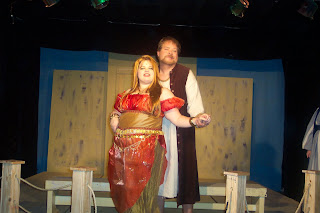

Okay, here it is, big confession.....I don't.....know how....to sew. Or at least, that is I didn't until our recent production of
Two by Two, a musical comedy base d on the story of Noah's Ark. when faced with the reality that we did not have fitting costumes for our female cast I did what any cool headed director would do, I panicked!
After I calmed down I began to assess the situation and came to the conclusion that it was time after twelve years fo building costumes with staples and hot glue to bite the bullet, buy a patern and get sewing!
Here are Mark's top ten tips for beginning tailors.
Number ten: Start small. I bought the easiest pattern I could find that gave me the look I wanted. Anytime you are learning something new, if possible give yourself the best odds of success and start simple.
Number nine: Stick to the script. on the back of your pattern package there shouldbe a list of materials you need, buy them! don't assume you understand what they will be used for if you have never done this before.
Number eight: Seek expert advice. Unlike home centers, who generally hire anyone with a pulse, fabric stores are usually staffed by knowledgeable people who are more than willing to help someone get started in their favorite hobby. thye can help you sort out what kind of elastic, thread, hook and eye fasteners, etc. you will need to make success a surety.
Number seven: Take your time. Do not go when you have fifteen minutes to spare. Even with the expert help you will need plenty of time to navigate this newfound universe. Just like any other project the planning period is often the most essential, so get it right.
Number six: Make sure you have the right tools. No the "craft" scissors will not do for cutting through the heavy faux fur and denim you will need to create that stunning Xena Warrior princess outfit. Get good scissors, extra needles, plenty of thread and anything else your expert suggests that fits into your budget. Remember if all goes well you will be using this stuff again.
Number five: Watch someone else do it. Teh first time you need to thread the machine or fill a bobbin you will want someone to demonstrate the proper technique, trust me. So call Mom or Grandma and ask them for a lesson or two. IT shouldn't take long but will save you hours of trying to unriddle the directions in "You Can Sew" or whatever publication you picked up in the junk store, besides the woman on the cover has a beehive hairdo, how current can the info be?
Number four: Start cheap. Don't go out on a limb with forty dollar a yard fabric on your first time out. If you have to abandon this sucker midstream you don't want it taking down your entire costume budget with it. Go to Wally World 10% of them still sell fabric, and they have discount tables. As always start at the cheap stuff. If they have what you want you win and if not you can always spend more.
Number three: Read the instructions. Before cutting any fabric, or even cutting your pattern out read the instructions and decipher the pictures. Call for help on any terms you don't understand. Look at a similar finished garment if possible to help you understand, but whatever you do, understand it before you do it.
Number two: Don't be afraid. You bought cheap fabric, you know how not to set off the self destruct on the machine, how bad can it get? the worst thing that happens is you have to start over or get help. As a side note to this one, fix your mistakes as you catch them so they don't pile up and ruin the effort.
And the number one tip: Have fun. Enjoy your completed creation, send us pictures, wear it with pride. You have accomplished something many people are afraid to try,you can sew. Although I caution you not to spread that around.People like me are always looking for people like you to do stuff like this, so don't offer unless you mean it!
I've included a pic of my first effort, be sure and leave lots of nice coments about the superior quality of my work!

















